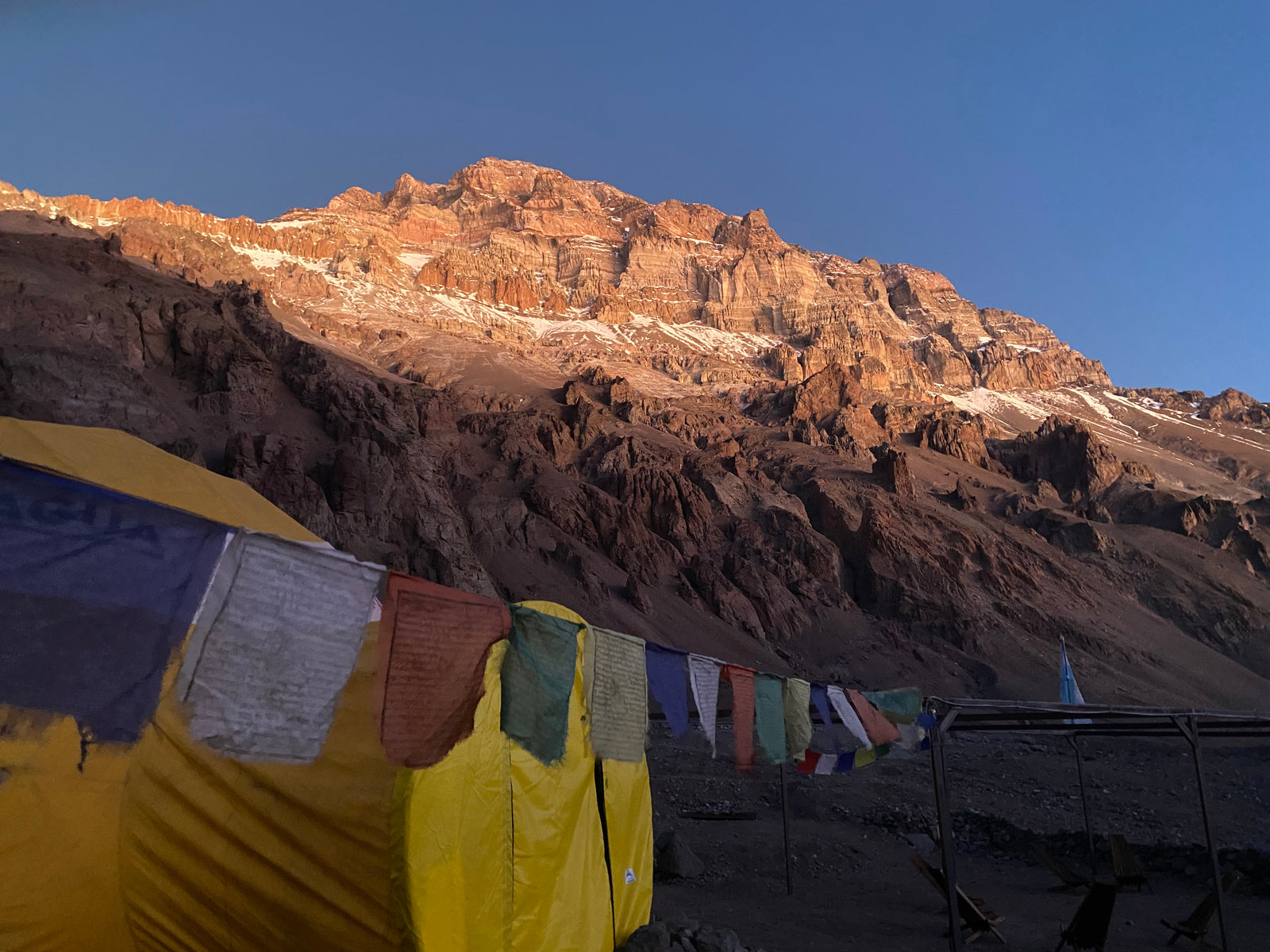For most of my motorcycling career, I kept my wheels on the pavement. That’s not to say I didn’t embark on the odd moto-camping trip, but my general belief was that taking motorbikes into the wilderness was loud, obnoxious, and essentially cheating. My climber and skier friends in Colorado used to call ATVs and motocross bikes “Texas wheelchairs” (reckoning the riders were only riding because they were too lard-assed to hike in on their own two legs).
This changed when I realized I was still using a car to get to mountain trailheads in the first place. Unlike my little Subaru, motorcycles could take me from my garage all the way to the base of the mountains. In fact, traveling to the wilderness by motorbike saved me money on gas, lowered my carbon footprint, resulted in less congestion on the road, easier parking at the trailhead, and an overall better experience. (I spoke about this on a recent episode of Adventure Rider Radio, and have written about it for Outside.)

Packing in to climb Mt. Shasta (14,179 ft), the second-highest peak in the Cascades.
For many, motorcycling is an end in and of itself. But for motorcycle campers, climbers, paddlers, skiers, fishermen (and so on), motorcycling is also a means to an end. Motorcycles are how we access the outdoors.
From late July through mid-September, I spent 50 days living off of the new Royal Enfield Himalayan 450, traveling from California to Nevada, Utah, and Oregon, trying to finish a personal goal of mine: climbing—alone—the 75 mountains higher than 14,000 feet in the contiguous 48 states. At the end of my trip, my log rested at 69/75 summits. Close, but no cigar for now.
I tackled plenty of mountains, and even though I didn’t hit my 75th 14er, the trip wasn’t without rewards, chiefly in the form of memories made and lessons learned. Here are six of the latter.

1. Bring a Light Kit
Motorcycle camping already works best when you bring the lightest, most compact gear. But when you’re simply hopping off your bike and pitching a tent, you can pretty much bring all the gear you can safely ride with.
When you’re parking your bike and hauling that gear on your back out into the backcountry—whether you’re going rock climbing, backpacking, packrafting, or something else—lighter and smaller start to take on a whole different meaning.
Now, your body is the engine.
The biggest issue I found was combining safe riding gear with camping gear with climbing gear. The Himalayan’s top box and hard panniers offered plenty of space, but at the end of the day, a motorcycle is a motorcycle. You’re never going to have an SUV trunk or pickup truck bed’s worth of gear space.
Consider weight and spacing-saving alternatives like:
- Water purification tablets instead of a filtration pump
- A collapsible, frameless trekking pack instead of fixed frame pack
- Compression sacks and packing cubes—these also work great as pillows!
- Soft bowls and mugs instead of metal, ceramic, or hard plastic dinnerware
- Collapsible water storage bladders instead of rigid plastic or metal water bottles

2. Gas Up
This one may seem like a no-brainer, but it’s bitten me in the ass more than once. When frontcountry motorcycle camping, you may never be more than 20 miles from a gas station. But heading to a remote trailhead, you have to plan for the approach, the return, and all the gas-guzzling antics and tire-spinning as you navigate obstacles in between.
When you’re riding to ride, your bike and its health are always front and center of your mind. But when you’re focused on climbing a mountain, hiking a trail, or fishing a remote river, the motorcycle takes a back seat, and it’s easy to forget about seemingly obvious checklist items like, “How much fuel is in my tank?” Before you head in for a wilderness objective, figure out your range, and ensure you have enough gas to get out and back. Then tack on an extra 30 miles or so extra for good measure.
If your tank is pretty skimpy, carrying extra fuel in jerry cans (or better, soft-flask bags) is a smart practice. This will give you a reliable and portable way to extend your range, and a crucial backup in case of detours or delays.


3. Helmet Questions
I’m going to assume we all wear helmets here. But when you bring a helmet with you and plan to park your bike in the wilderness for days at a time, you don’t just have to ask yourself basic questions like “Does this thing protect my head?” “Is it comfortable?” and “Do I look cool?” but also new questions, like, “How will I secure this thing to my bike when I’m out on the trail?” and “Am I really okay leaving this thing attached to my bike for days on end?”
Even if you have a locking top box that you normally stash your helmet in, chances are you’re going to be stashing riding gear (pants, jacket, gloves, maybe even boots) in those lockers as well, so if you can secure your helmet to your bike, you’ll save tons of space.
Open face helmets, and old-school models with fixed face shields, are very hard (if not impossible) to lock to your bike. Expensive helmets with lots of bells and whistles may also not be a great choice. I like to opt for a reliable, but cheap helmet. (If you lock your helmet on your bike, don’t forget to remove your Cardo, Sena, or other audio or comms system from the outside of your helmet, too.)

4. Bigger Isn’t Always Better
Adventure riding has a few upper echelon heavyweights that seem to get all the acclaim; the BMW R 1250 GS, Honda Africa Twin, Triumph Tiger, and Harley-Davidson Pan America, to name a few. Midweight models like the Suzuki DR650, Kawasaki KLR650, Ténéré 700 are also lauded.
But small bore, single cylinder bikes, like the Royal Enfield Himalayan 450 I rode on my most recent trip, are increasingly becoming my preference for motorcycle-powered adventures. ADV Pulse does a good job breaking down the reasons in this article, but for me, in terms of upfront price ($5,799 for the new Himalayan) and gas mileage, little bikes like this are hard to beat. They’re also lighter—so much easier to handle—cheaper to maintain, and often hold up better against drops and other abuse.
5. Use Lockable Boxes and Panniers
Soft panniers and tank and tail bags offer countless benefits over hard cases, and if you’re spending the night a stone’s throw from your bike, they’re probably the best choice. But if you’re leaving your bike at a wilderness trailhead for several days while you head out on foot, locking panniers and hard cases are something you should consider. Most thieves are opportunists, and motorcycles are easy pickings. If they see a soft saddlebag and no one’s in sight, they’ll likely rifle through it. When you put locking panniers on your bike, it becomes no more appealing than any other locked car at the trailhead.

6. Go Slow
I’m sort of talking about the throttle here, but not really. When trying to accomplish a goal using your motorcycle as your vehicle, you’ll almost always run into snafus. That’s part of the beauty. Rainstorms and high winds. Flat tires and freezing temps.
If I’d really wanted to give myself the best chance to climb all the 14ers, I would’ve just taken a car. If I had, I might be sitting here with 75 summits instead of 69. But for me, it was more about the experience than hitting the goal. That’s why I used a motorbike.
When your mind is set on climbing a mountain or paddling a river, and the motorcycle is just the method to get you there, sometimes you forget that the approach isn’t a given.
Things go wrong. So go slow. Keep a cool head, and don’t take anything for granted.

Owen Clarke is an American action sports journalist primarily covering rock climbing and adventure motorcycling. He has ridden (and crashed) motorcycles on six continents. Among other roles, he is a frequent contributor to Climbing, Outside, and Summit Journal, and is the Africa Climbs & Expeditions editor for the American Alpine Journal.

